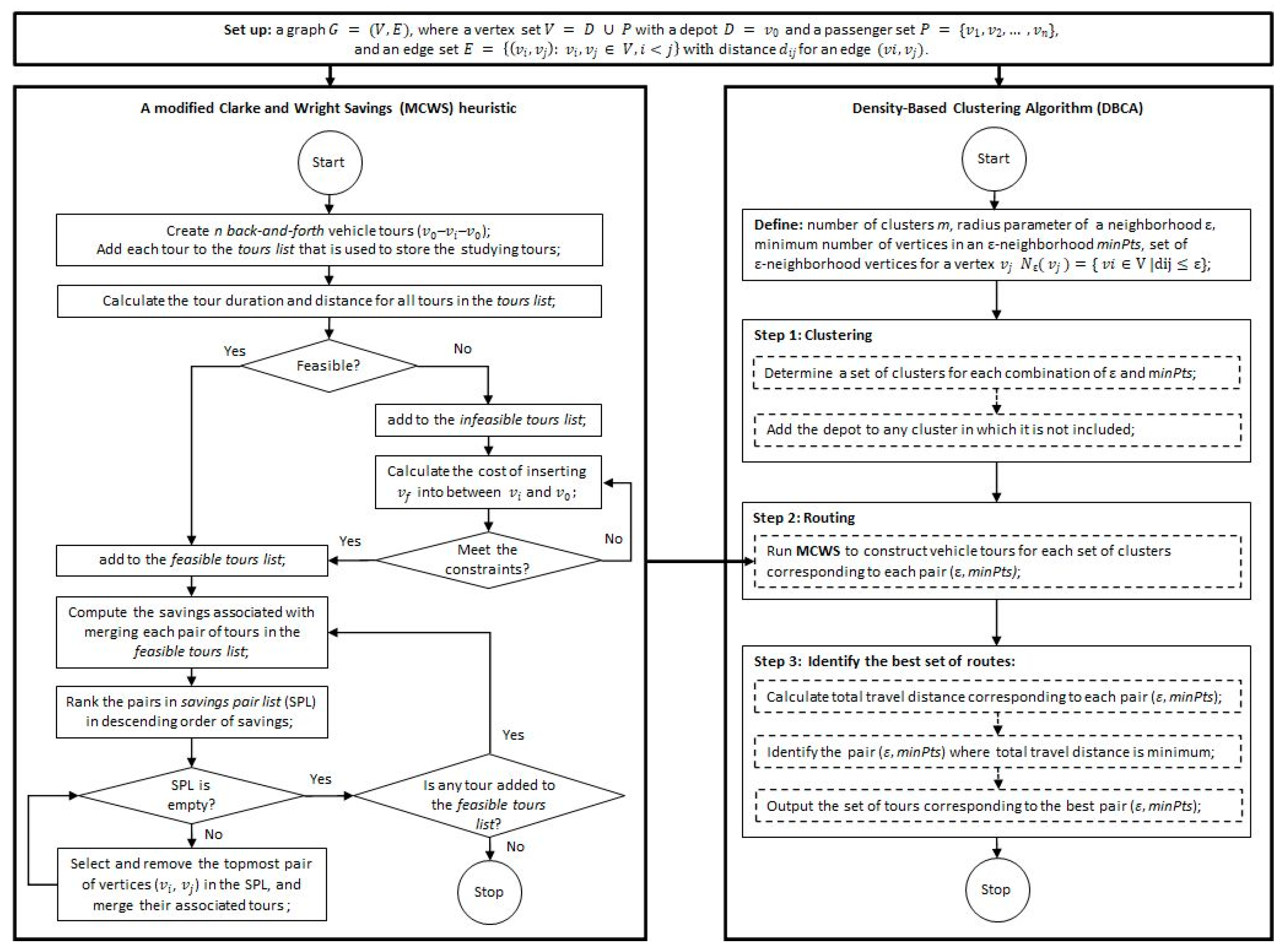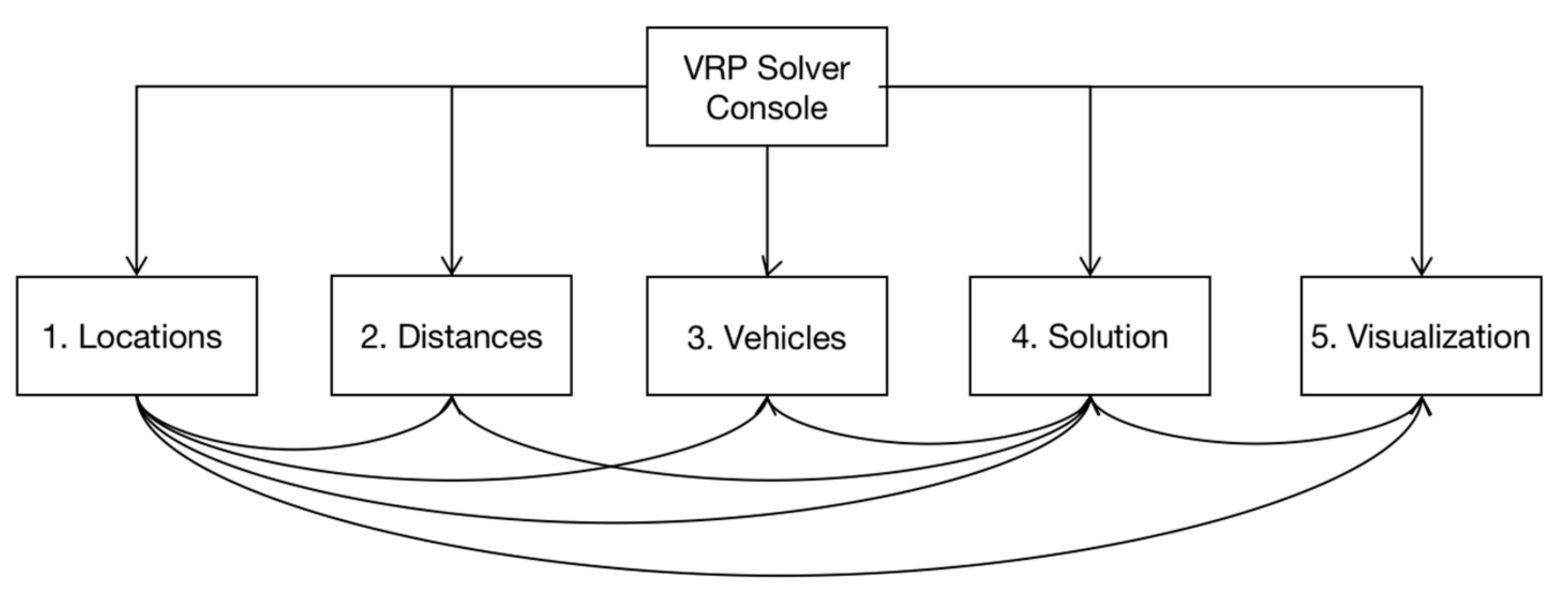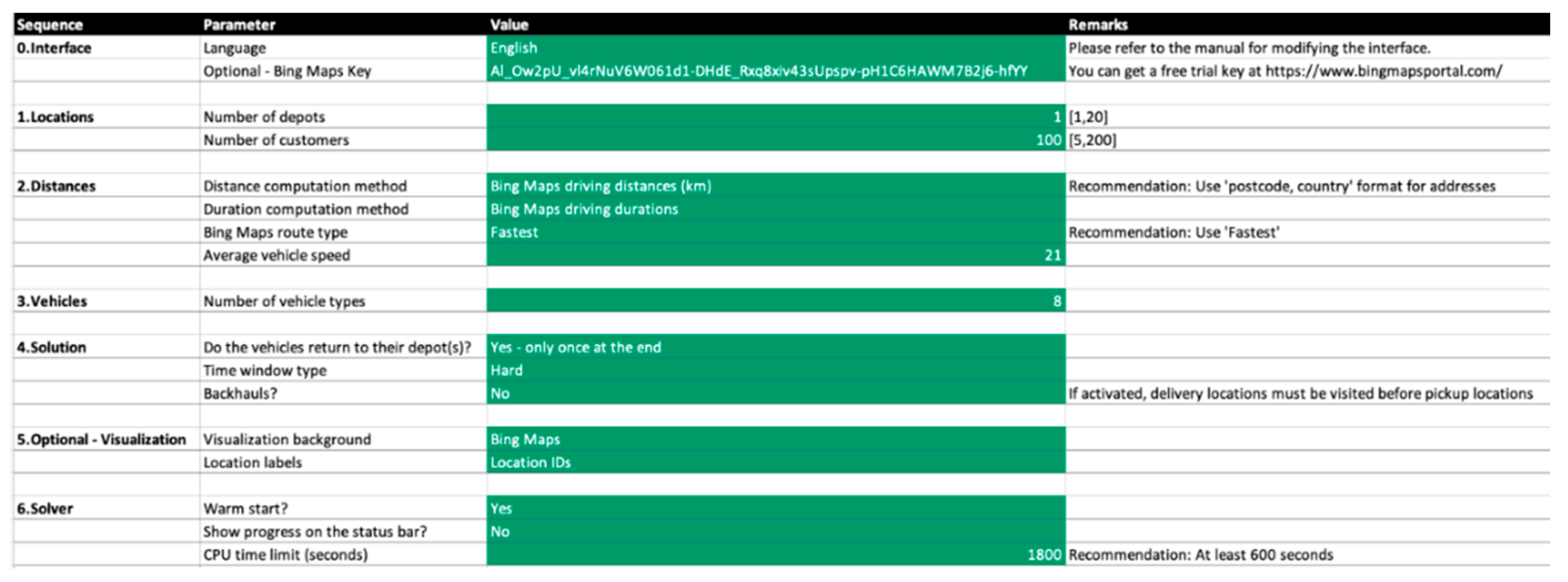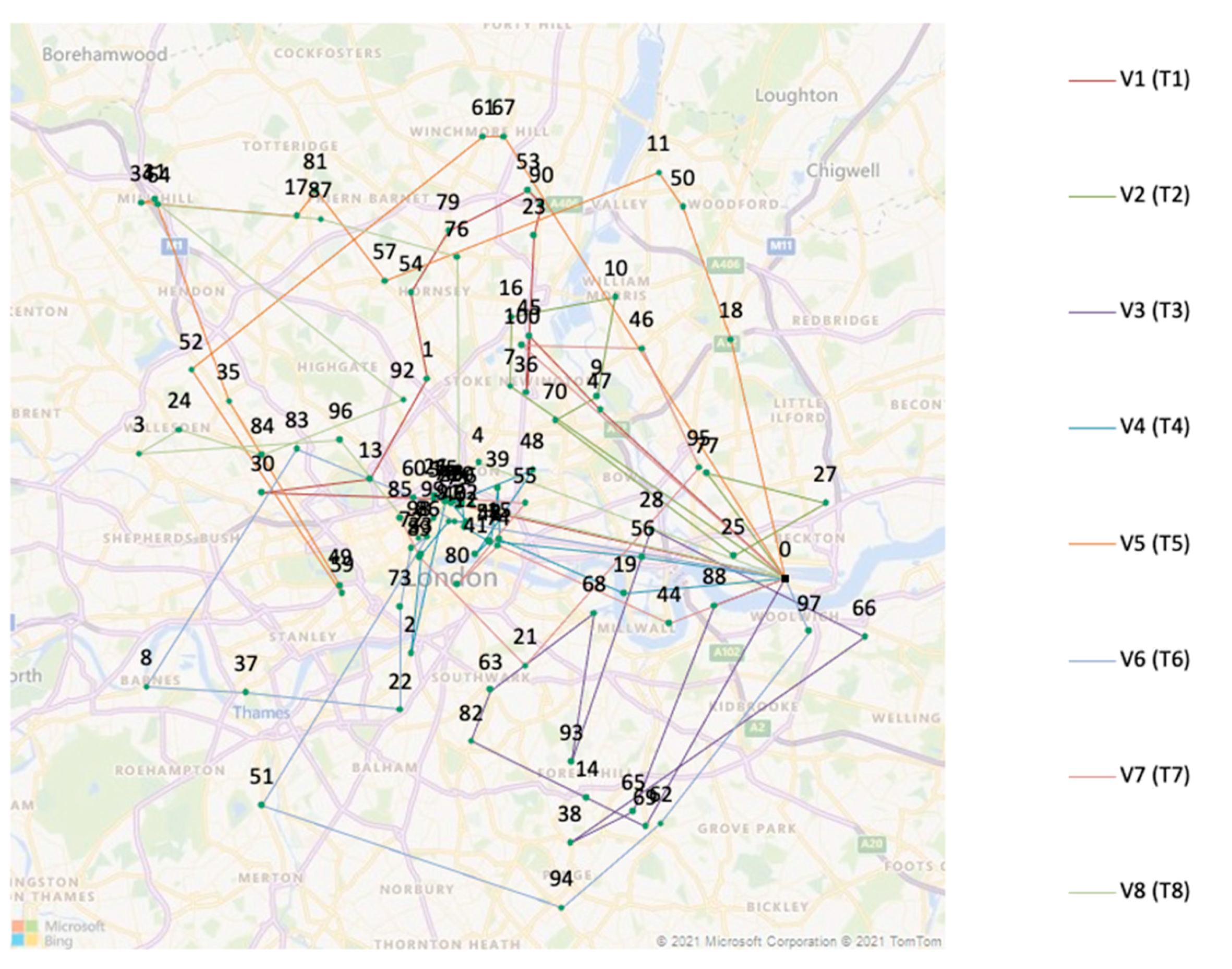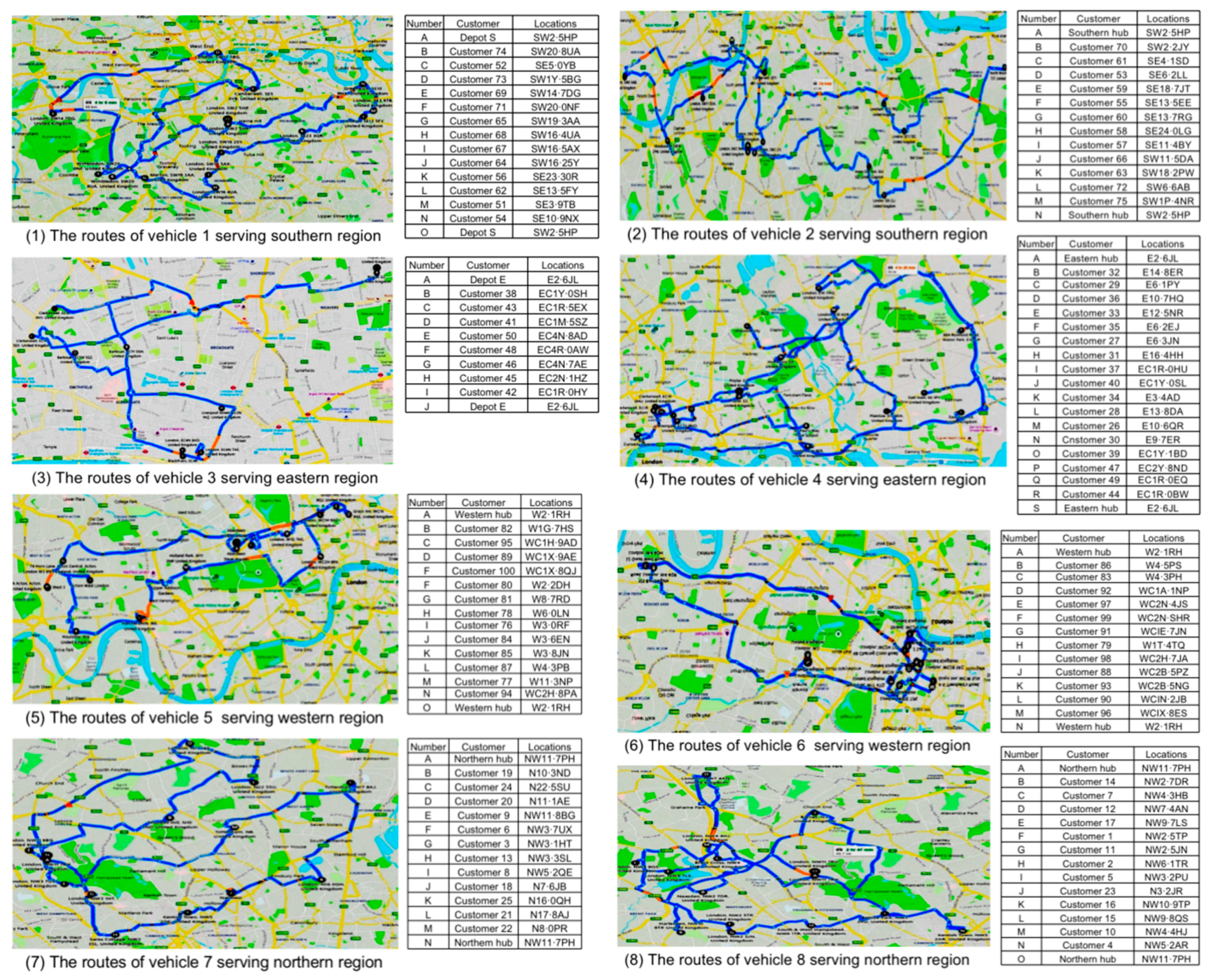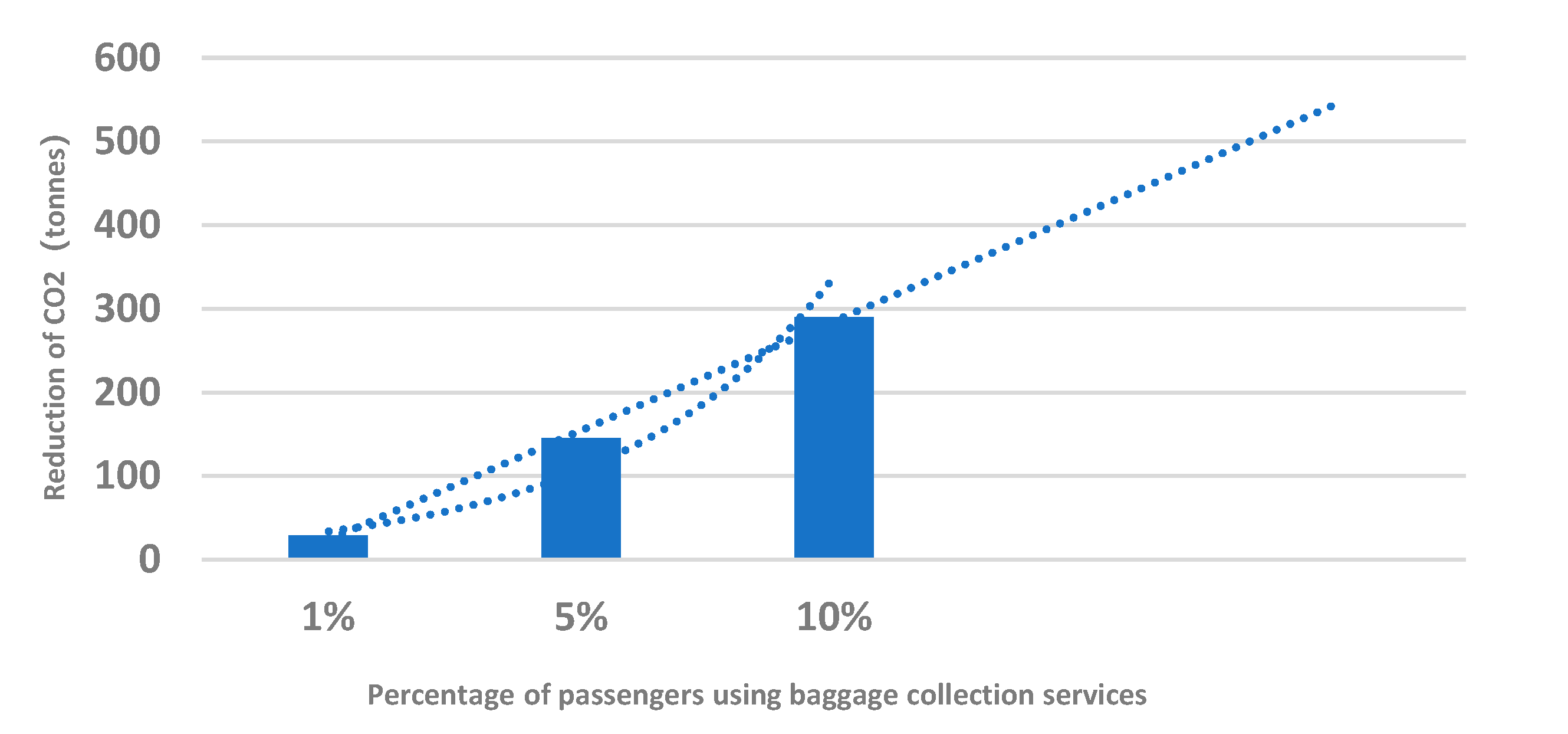1. Introduction
The International Air Transport Association (IATA) [
1] predicts that over 10 billion air passengers will be carried by 2050 (approximately traveling 20 trillion kilometers each year), which will generate about 1800 megatonnes (Mt) of carbon emissions and lead to challenges of passenger and baggage flow management at airport terminals. The aviation industry has embraced this challenge and a wide range of measures are now being implemented to solve the issue toward the net-zero carbon goals. The baggage-free airport terminal (BFAT) is considered a potential solution for the goal of sustainable airports. The BFAT builds new links between airports and cities, investigating the expansion of the baggage collection from home. In particular, the BFAT removes the baggage operation away from the passenger terminal via multiple injection points connected to highly efficient baggage fulfillment centers [
2]. The service will pick up passengers’ baggage at a selected time window on the doorstep, assign a QR code to each baggage and deliver the baggage to the assigned depot (logistic hub or airport). Passengers will be encouraged to use public transport during their journey; in the meantime, baggage will be delivered directly to the destination (home or hotel address). Augmented reality (AR) will be used to help passengers quickly double-check their baggage to avoid any mishandling. Hence, the BFAT effectively manages the baggage flow between the airports and the cities, liberating the passengers from their baggage and reducing airport-related carbon emissions.
The location-routing problem (LRP) is one of the main tasks of the BFAT, identifying the optimal location of logistic hubs and planning the optimal vehicle routes for baggage collection and delivery. For a comprehensive literature review of recent research on LRP we refer to [
3]. Since the location of logistic hubs will be specified in our study, we focus on solving the vehicle routing problem (VRP). The VRP includes a growing number of variants, such as time windows [
4], multiple depots [
5], multiple trips [
6], heterogeneous fleets [
7], and green vehicles [
8]. The green vehicle routing problem (GVRP) investigates the negative environmental effects of vehicle transportation. The GVRP expands the traditional VRP’s objective function, in addition to transportation distance, transportation time, and other transportation economic costs, transportation environment cost (e.g., greenhouse gas emissions) is also considered. Bektaş et al. [
9] first set carbon emissions as the objective function of VRP. Franceschetti et al. [
10] established a GVRP model with time windows to avoid traffic congestion and significantly reduce carbon emissions. Koç et al. [
11] found that a fleet with different types of vehicles can reduce pollutant emissions during transport. Zhang et al. [
12] developed a two-stage ant colony system (TSACS) to minimize the total carbon emissions on GVRP. Ge et al. [
13] introduced the objective functions of cost-saving, energy-saving, and low-carbon cost to the traditional VRP models. The authors designed an improved genetic algorithm for solving this problem. They compared the low-carbon routing with the shortest routing and found that despite the increase in mileage, the carbon emissions have been greatly reduced. The research on the electric vehicle routing problem (EVRP) is a further expansion of the VRP problem [
14]. Compared with traditional fossil fuel-powered cars, electric vehicles (EVs) emit fewer greenhouse gas emissions. However, EVs have technical bottlenecks such as smaller transportation coverage and fewer energy replenishment stations. Erdoğan and Miller-Hooks [
8] considered EVs into the GVRP models by adding the energy supplement facilities and vehicle travel distance constraints. They provided an effective routing method for EV companies. Felipe et al. [
15] proposed the routing problem of electric freight vehicle transportation, considering the time and the charge amount of each EV charging. Schneider et al. [
16] developed a new hybrid heuristic algorithm for the electric freight vehicle routing problem with a time window. Omidvar et al. [
17] studied additional constraints such as vehicle load and congestion management and incorporated various metaheuristic methods into their solution. According to the International Energy Agency (IEA) [
18], a significant number of EVs (around 125 million) will be on the road by 2030. Using EVs for baggage collection and delivery in the BFAT will thus be a future trend. It will be essential to seek solutions for the BFAT toward a sustainable airport industry.
This paper focuses on the VRP with the specified location of logistic hubs for the BFAT’s baggage collection service. The aim is to build a decision support tool for the implementation of a baggage collection service network in airport transportation. This paper discusses the design of an optimal baggage collection network, including the selection of the logistic hub locations and the optimal vehicle routes for baggage collection. A spreadsheet solver tool, based on the integration of the modified Clark and Wright savings heuristic and density-based clustering algorithm, is adopted to find the optimal vehicle routes under different scenarios. For the case study at the London City Airport (LCY), the costs and carbon emissions of using a single depot or multiple depots are investigated and compared. An AR-based innovation is proposed to improve the efficiency of traditional logistics. In summary, this paper makes the following contributions: (i) study a baggage collection service network design problem for future BFATs; (ii) adopt a spreadsheet solver tool to find the optimal vehicle routes for baggage collection; (iii) propose an AR-based baggage tag visualization application, which is useful to reduce any mishandling; (iv) apply the model for the case study at the LCY.
The remainder of the paper is organized as follows:
Section 2 describes a spreadsheet solver tool for solving the studied VRP. The case study at the LCY is presented in
Section 3.
Section 4 is the quantitative analysis of the carbon emissions reduction for the LCY. The AR-based application for baggage tag visualization is presented in
Section 5. Lastly, the conclusion and future work are given in
Section 6.
2. VRP Spreadsheet Solver Tool
This paper studies the GVRP with a homogeneous fleet of EVs for the BFATs. A spreadsheet solver tool [
8] is adopted to solve the GVRP under various scenarios. The solver is developed on the integration of the Modified Clarke and Wright Savings (MCWS) heuristic and the density-based clustering algorithm (DBCA). The MCWS heuristic is applied to construct vehicle tours for each set of clusters in the DBCA’s routing step. The overall aim is to seek a total minimum travel distance for a fleet of EVs that start at a depot, visit a set of customers exactly once, collect their baggage, and return to the depot. A flowchart of the integrated algorithm for the GVRP is shown in
Figure 1.
The tool has a unified graphical user interface platform to support users easily to input the data, output the result and visualize the solution. It includes geographic information system (GIS) facilities that allow users to incorporate driving times and distances. The structure of this tool (Locations—Distances—Vehicles—Solution—Visualization) is shown in
Figure 2.
The console spreadsheet breaks down each sequence and provides essential information for each upcoming stage as shown in
Figure 3. Users can run the GVRP model with the following six sequences:
- -
Sequence 0 (Interface): Retrieve GIS data and establish delivery points for the later sequence.
- -
Sequence 1 (Locations): Define the number of depots (e.g., 1–20) and the volume of passengers (e.g., 5–200).
- -
Sequence 2 (Distances): Set computation method of distance and driving duration, including Euclidian distances, rounded Euclidian distances, Hamming (Manhattan) distances, Bird’s flight distances, and Bing Maps driving distances.
- -
Sequence 3 (Vehicles): Input the number of homogeneous vehicles for simulation (e.g., 8).
- -
Sequence 4 (Solution): Set vehicles returning mode and time window type.
- -
Sequence 5 (Visualization): Provide visual representation to users, including visualization maps, location IDs, location names, service time, pickup amount, and delivery amount.
- -
Sequence 6 (Solver): Start simulation, show progress and result.
The locations spreadsheet includes passengers’ postcodes, time windows, and pickup amount data from the Civil Aviation Authority (CAA), and the subsequent GIS data (longitude and latitude) from Bing Maps (
Figure 4). The distances spreadsheet (
Figure 5) calculates the distance and driving duration between every two positions stated in the locations spreadsheet. The vehicles spreadsheet lists different attributes, parameters, and working scenarios. Each vehicle has approximately 14 m
3 storage capacity with a standard size of baggage and an 80% capacity utilization rate [
19]. The duration multiplier refers to the return driving times for an average-sized vehicle. With the increase in size, speed, and the number of baggage, the duration multiplier is increased by 20%. To keep EV batteries recycled, the distance limit is set to 270 km (80% driving range), as shown in
Figure 6. The solution spreadsheet shows passenger-driver solutions based on ‘Locations, Distances, Vehicles’ spreadsheets (
Figure 7). The visualization spreadsheet shows the customer locations and vehicle routes with a scatter graph (
Figure 8).
3. A Case Study of the London City Airport
The LCY is chosen to validate the model since it is the closest airport to Central London and manages a large number of passengers. In 2019, the LCY handled about 5 million passengers. The CAA shows that 91.8% of the LCY’s passengers depart from the Greater London area [
20] (see
Table 1). In the 2019 Departing Passenger Survey conducted by the CAA, nearly 56% of passengers used private cars to travel to airports, while 44% of passengers used public transport. Private cars emit more greenhouse gases per passenger mile than trains and coaches. Hence, one of the main sources of airport-related emissions is using airport approach roads. Decarbonizing road transport systems to airports has posed challenges to the UK Department of Transport.
In the case study, we focus on a baggage collection service network design from passengers’ sources to the LCY that aims to mitigate the burden of baggage management from passengers and at the airport’s check-in process. The mitigation can encourage passengers to use more public transport to the LCY and reduce airport-related carbon emissions. A similar planning model can be extended for the baggage delivery problem from the airport to the passengers’ destination (home or hotel address).
In the case study, two design scenarios are considered and compared, i.e., one hub at the LCY and multiple logistic hubs in Greater London. In the first scenario (i.e., one hub at the LCY), passengers book baggage collection online, then the entire baggage check-in process happens on the doorstep, finally, the EVs transport all the collected baggage directly to the LCY. In the second scenario (i.e., multiple logistic hubs in Greater London), passengers can bring their baggage to the nearest logistic hub by themselves or can book baggage collection online. Different from the first scenario, the second one aims to deliver the collected baggage to the nearest logistics hub, then unload the baggage from EVs, and finally transport them to the LCY together [
21]. In this paper, we compare the transportation distance, transportation cost, and carbon emissions of the solutions for these two scenarios. The spreadsheet solver tool is used to optimize the scenarios and visualize the solutions. The following are assumptions and data of the case study:
- -
A one-to-one service between each EV and passengers without repeat.
- -
Randomly generate passengers’ location and the number of baggage.
- -
A total of 100 passengers book this baggage collection service.
- -
Maximum 30 bags in each EV.
- -
A 20 miles per hour of average vehicle speed.
- -
The range of EVs is up to 211 miles, an ‘Arrival van’ costs GBP 37.24 to charge 80% [
22].
- -
Driver’s working hour is limited to be 8 h [
23].
- -
The on-doorstep check-in takes an average of 5 min per baggage, including scan, record, encapsulating, and loading baggage.
- -
24 h service with three shifts: 8 a.m., 4 p.m., and 12 p.m.
- -
Bing Maps driving distances are used for calculating Evs’ driving distances.
- -
The EV will only return to the depot after completing their route.
Appendix A shows 100 randomly generated passengers and their locations.
Table 2 shows that 8 EVs are required to serve these 100 passengers. Using the spreadsheet solver tool for the first scenario (i.e., one hub/depot at the LCY), the total travel distance is 377.40 miles during one shift (8 h), the total cost is GBP 335.66 (see
Appendix B), and the optimal routes of 8 vehicles are shown in
Figure 9.
In the second scenario (i.e., multiple logistic hubs/depots in Greater London), the center of gravity approach is used to calculate the optimal location of the logistics hubs with the following assumptions [
24]:
- -
The passenger’s location and the number of baggage are known.
- -
The costs are only determined by the distances between a logistic hub and the passenger’s location without considering city traffic.
- -
The land-use fee, labor fee, and future profits are not considered.
Based on the assumptions, distance is the only factor that needs to be considered. Denote that
is x-coordinate of logistic hub
j,
is y-coordinate of logistic hub
j,
is the number of passengers that logistic hub
j serves,
is x-coordinate of passenger
i,
is y-coordinate of passenger
i, and
is the number of baggage w.r.t passenger
i, then the location of logistic hub
j is defined by:
Greater London is divided into four regions with the corresponding postcodes such as North (NW and N), East (E and EC), South (SE and SW), and West (W and WC). In the baggage collection service, a certain logistic hub only serves one region. For example, EVs departing from the North hub serve passengers in postcodes NW and N. When applying the center of gravity approach, the locations of logistic hubs are shown in
Table 3.
However, it is difficult to set up the simulated coordinates as the final location of logistic hubs due to road traffic, passenger distribution, costs, and land availability. A logistic hub connecting to the highway, railway, and roadway can improve operation efficiency [
25]. Land availability is an important factor. A new logistic hub requires unused lands and devices, which could be the main cost of building hubs [
26]. For baggage delivery services, public hubs, including supermarkets, post offices, rail stations, and bus centers, are recommended as logistic hubs, which minimize the total cost compared to developing new hubs. In this case study, the final selected logistic hubs are the public places nearest to the simulated coordinates such as Royal Mail, Bethnal Green station, Brixton Hill post office, and Paddington station (see
Table 3 and
Figure 10). Using the spreadsheet solver tool for the second scenario, we achieve the following optimal solution. The total travel distance is 354.31 miles during one shift (8 h), the total cost is GBP 511.72 (see
Appendix C), and the optimal routes of 8 vehicles are shown in
Figure 11.
The comparison results of the solutions found in the first scenario and the second scenario are shown in
Table 4. The second scenario produces the solution with a shorter total travel distance. However, additional trucks could be required to deliver the baggage from the hubs to the LCY, increasing the fixed cost of each hub to purchase EVs, trucks, and land rental costs. Therefore, in the case study of the LCY, the first scenario is the best solution. It can balance total travel distance and cost. The first scenario’s collection operation is divided into various activities, including fixed costs and variable costs [
27]. The variable costs (i.e., costs of each activity) are shown in
Table 5 in which the labor cost is from the Totaljobs website, and the AR label is reusable. The equation of cost per baggage is computed as follows:
4. Carbon Emission Reduction for the London City Airport
Three cases, defined by passenger’s preference for using the BFAT service, are analyzed to predict the popularity of baggage collection service and calculate the reduction of carbon emissions in the next few years [
28,
29]. The calculation steps for the reduction of carbon emissions are as follows:
- -
Step 1: Using the simulation results to calculate the total distance that passengers traveled without baggage collection service.
- -
Step 2: Using the CAA data and the proportion of private cars to calculate the total distance that passengers traveled by private cars.
- -
Step 3: Using the average vehicle carbon emission data in the UK to calculate total carbon emission from private cars used by passengers.
- -
Step 4: Using the proportion of passengers who switch from private cars to public transportation to calculate the potential carbon emission saving by baggage collection service.
- -
Step 5: Using the predicted passenger number to calculate the carbon emission saving per passenger and carbon emission reduction per day.
The LCY served about 5 million passengers in 2019, 91.8% of which are from Greater London. Passenger demand is predicted up to 6 million by 2025 [
20]. A total of 56% of the passengers use public transport to the LCY, while 44% of the passengers use private cars and taxis. Let
be the percentage of passengers who convert from private mode to public mode. In the case study, assume that 90% of passengers that are using private cars can switch to public transport, then
, and the total travel distance to the LCY of 100 customers is 749.70 km. The equation of average carbon emissions is shown as follow:
where CO
2 per km is based on the ‘ASM Auto Recycling’ [
30], i.e., the average CO
2 emission per vehicle is 125.1 kg/km in 2018, the CO
2 emission of private cars and taxis is 1.27 kg/km.
Total reduced CO
2 emission is defined by:
In the first case (i.e., low preference for the BFAT service), we assume that 1% of passengers will use the baggage collection service by 2025. The results show that the total daily reduced CO
2 emission for 160 customers is 79.48 kg. As a result, the baggage collection service will reduce 29.01 tonnes of carbon emissions annually. In the second case (i.e., medium preference for the BFAT service), we assume that 5% of passengers will use the baggage collection service by 2025. The total daily reduced CO
2 emission for 360 customers is 397.40 kg (i.e., 145.05 tonnes of carbon emissions annually). In the third case (i.e., high preference for the BFAT service), we assume that 10% of passengers will use the baggage collection service by 2025. The total daily reduced CO
2 emission for 360 customers is 794.79 kg (i.e., 290.10 tonnes of carbon emissions annually).
Figure 12 shows the comparison results of CO
2 emission reduction in three cases.
5. Application of AR for Baggage Tracking
Late deliveries, damaged baggage, and mishandled baggage can all be red flags in baggage collection service, therefore, baggage tracking is proposed as a solution. With the rapid development of technologies such as radio frequency identification (RFID), barcodes, QR codes, and AR, courier and delivery companies have been tracking parcels and providing customers with real-time information for quite some time. Currently, many delivery companies use simple barcodes for baggage handling, which is cheap and simple technology. However, barcodes require a handheld scanner with 60–70% read rates, which reduces staff efficiency and increases the frequency of mishandling baggage. Many delivery companies use RFID for baggage identification and tracking, which is expensive and requires an additional reading scanner [
31]. AR technology with QR codes allows passengers to track baggage in real-time without handheld devices. The technology can decrease the need for manual processing and free up staff for other value-adding tasks. Passengers can even check their baggage by themselves with a simple mobile app. The procedure is described as follows (see
Figure 13):
- -
Step 1: Collect passenger’s baggage.
- -
Step 2: Assign a QR code to each baggage.
- -
Step 3: Deliver the baggage to the hub.
- -
Step 4: Deliver the baggage onto the aircraft.
- -
Step 5: Scan the QR code for a double check when custody changes between carriers.
- -
Step 6: Deliver the baggage to the passenger’s destination.
- -
Step 7: Passengers or staff scan the QR code to check baggage-passenger information to avoid mishandling.
AR technology with QR codes is an easy and cost-effective way to obtain baggage tracking records. It reduces the number of lost, delayed, and mishandled baggage and improves the customer experience. With AR glasses or AR-based mobile app, the baggage collection service will reduce the cost and time of baggage double-checking, as well as help eliminate baggage fraud. The goals of QR codes and AR-based baggage collection service implementation are to increase customer satisfaction, eliminate mishandling, improve information visibility, reduce manual labor costs, and reduce delivery delays [
32]. Hence, the AR technology for baggage tracking system is proposed to integrate into the BFAT for the efficient management of the baggage collection and transport network.
6. Conclusions and Future Work
The transformation of the passenger baggage experience is gathering pace. A transparent, real-time tracking baggage collection service will make a more relaxing journey that will encourage passengers to use more public transport (after the burden of baggage is removed) for air quality improvement. This paper investigates a baggage collection service network design problem using vehicle routing strategies and AR technology toward the goal. A spreadsheet solver tool, integrating MCWS and DBCA, is adopted to solve the problem and simulate the optimal routing networks and logistic hubs. This tool can solve to optimality the problem with a maximum of 200 nodes. The LCY is used as a case study to demonstrate the efficiency of the proposed model and tool for reducing airport-related carbon emissions. The results show that the model is efficient for the actual airport service. It can reduce 290.10 tonnes of carbon emissions annually in the case that 10% of passengers will use the baggage collection service by 2025.
In the baggage collection network, AR technology with QR codes makes the service quicker and easier to track baggage-passenger information. It provides extra information about the baggage journey and enables a faster process for baggage double-checking by passengers or staff to reduce baggage mishandling.
This paper aims to demonstrate the efficiency of the proof-of-concept planning model toward BFATs. The adopted spreadsheet solver tool has also achieved very good performance for the GVRP in the baggage collection network design. For larger-sized instances, other well-known metaheuristic algorithms (e.g., genetic algorithm, tabu search, simulated annealing, etc.) could be developed to improve the solution performance.
In addition, the model can be applied for other airports such as London Heathrow Airport, Manchester Airport, etc. A comparison of implementing the model for the airports will then be made to evaluate its applicability. Another future research approach is the baggage collection network design under the risk of unexpected failures to mitigate the impact of disruptions on the performance of network design.
